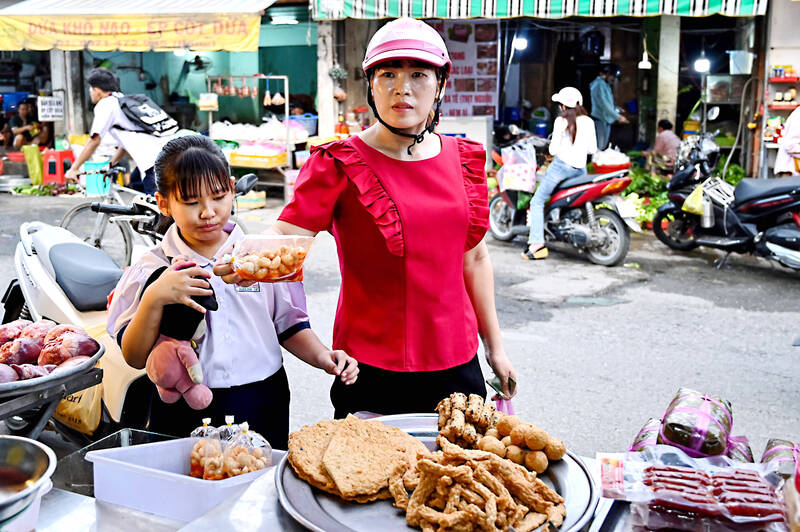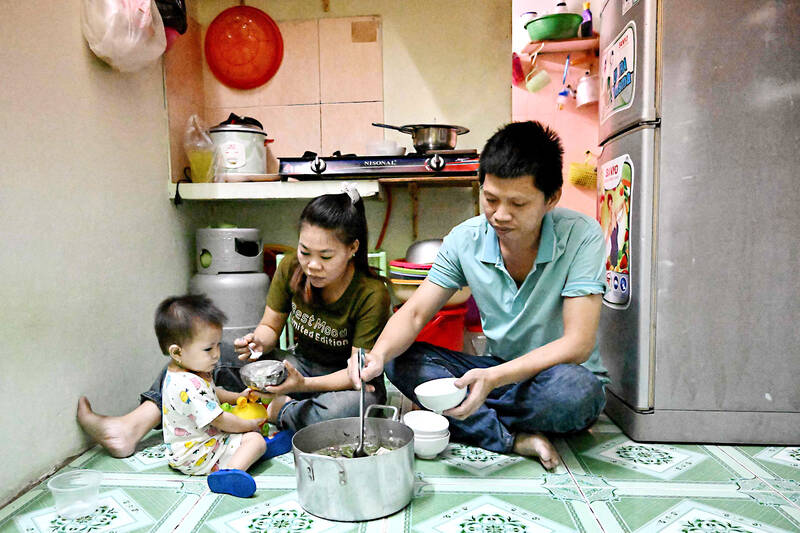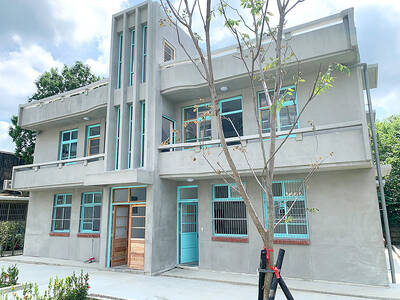Treading a familiar path for women in rural Vietnam, Nguyen Thi Hiep found a factory job in dynamic Ho Chi Minh City and spent 16 years helping make shoes for Western brands such as Adidas and Nike.
Vietnam is among the world’s largest exporters of clothing, footwear and furniture and Ho Chi Minh City and its hundreds of thousands of migrant workers have for decades helped power its manufacturing boom. The southern metropolis offered stable jobs with decent pay, and young women in particular flocked to garment and shoe factories, where the workforce is three-quarters female.
But as living costs surge, Hiep is joining a wave of workers rejecting the commercial hub for a quieter life back home — leaving city businesses struggling to fill their ranks.

Photo: AFP
“I have stayed in this city long enough,” Hiep, 42, said after her shift at a factory owned by Taiwan’s Pou Chen, one of the biggest and best-paying shoe manufacturers in the country.
“I work all day long, starting at sunrise and ending when it’s dark,” she said. “But I still struggle to pay my rent.”
Despite earning 10 million dong (US$400) a month, a third more than the national average, Hiep lives in a 10-square-metre, one-room apartment with her husband and eight-year-old daughter, buying the cheapest food she can find and saving nothing.

Photo: AFP
Housing, utility, healthcare and education costs are rising across the country, and workers in Ho Chi Minh City say their salaries can no longer meet their needs.
So Hiep and her husband, a motorbike taxi driver, have decided to leave.
This week, ahead of the Tet festival when Vietnam celebrates the lunar new year, the family will make the 1,000-kilometer journey home to a remote corner of mountainous Quang Binh province, 24 hours and a world away from the traffic and pollution of Ho Chi Minh City and its 10 million people.

Photo: AFP
They have no plans to return.
RAPID DEPARTURE
In the decades since Vietnam’s post-war “doi moi” economic transformation, Ho Chi Minh City and the capital Hanoi have been at the heart of the “from farm to factory” trend, said professor Pham Van Dai of the country’s Fulbright University.
It is a pattern that has played out in many developing countries across the world.
But when the Covid-19 pandemic forced people out of factories and back to their homes, many found rural areas had developed, offering more opportunities than a decade earlier and a higher quality of life.
“The number of migrant workers [moving out] rose rapidly,” Dai said.
In Binh Tan, a popular migrant district where Hiep lives, the number of temporary residents dropped by almost a quarter — more than 100,000 people — between 2020 and 2023, Le Thi Ngoc Dung, vice chairwoman of the local people’s committee, said to state media. And although new migrants are still arriving across the city, the number has fallen drastically — from 180,000 in 2020 to 65,000 people in 2023, according to the city’s population and planning department.
“When their income can no longer cover living costs” migrants will leave, Dai said.
“The city has not shifted quick enough to create better jobs.”
In 2022, more than 60 percent of Ho Chi Minh City’s migrant population had decided to leave or were mulling it over, a survey by the Vietnam Chamber of Commerce and Industry and the UN’s International Organization for Migration showed. More than half blamed high living costs.
LABOR SHORTAGE
Struggling to afford food and schooling, Truong Thi Le, also a Pou Chen worker, made the heartbreaking decision to send her six-year-old daughter to live with her uncle in Quang Binh.
After eight years in the city, she and her younger daughter will soon follow, leaving behind the poor air quality — which regularly exceeds World Health Organization’s guidelines by three to five times — that she says is making her children ill.
“We can’t make it work,” said Le, who together with her husband earns roughly 16 million dong a month, “and the environment in the countryside will be better for my kids,” she added.
Low income, small and dilapidated houses, separation from their children, overtime and night shifts: each contributes to migrant workers’ “increasing feeling of insecurity and lack of stability,” said Nguyen Thi Minh Ngoc, a manager at recruitment company ViecLamTot.
As stress levels rise and their health deteriorates, they leave despite knowing their income will drop, Ngoc said.
Business is beginning to feel the effects.
An August survey by ViecLamTot showed around 30 percent of manufacturers in the city faced a labor shortage, while 85 percent said they were having trouble recruiting.
For the workers themselves, the future remains uncertain.
Le said she might return to farming, while Hiep has thought of finding a factory closer to home.
In any event, she envies the simple life of her neighbours back home, “playing volleyball, getting together to sing and dance.”
In Ho Chi Minh City, she says, “life is too hard.”

June 2 to June 8 Taiwan’s woodcutters believe that if they see even one speck of red in their cooked rice, no matter how small, an accident is going to happen. Peng Chin-tian (彭錦田) swears that this has proven to be true at every stop during his decades-long career in the logging industry. Along with mining, timber harvesting was once considered the most dangerous profession in Taiwan. Not only were mishaps common during all stages of processing, it was difficult to transport the injured to get medical treatment. Many died during the arduous journey. Peng recounts some of his accidents in

“Why does Taiwan identity decline?”a group of researchers lead by University of Nevada political scientist Austin Wang (王宏恩) asked in a recent paper. After all, it is not difficult to explain the rise in Taiwanese identity after the early 1990s. But no model predicted its decline during the 2016-2018 period, they say. After testing various alternative explanations, Wang et al argue that the fall-off in Taiwanese identity during that period is related to voter hedging based on the performance of the Democratic Progressive Party (DPP). Since the DPP is perceived as the guardian of Taiwan identity, when it performs well,

A short walk beneath the dense Amazon canopy, the forest abruptly opens up. Fallen logs are rotting, the trees grow sparser and the temperature rises in places sunlight hits the ground. This is what 24 years of severe drought looks like in the world’s largest rainforest. But this patch of degraded forest, about the size of a soccer field, is a scientific experiment. Launched in 2000 by Brazilian and British scientists, Esecaflor — short for “Forest Drought Study Project” in Portuguese — set out to simulate a future in which the changing climate could deplete the Amazon of rainfall. It is

The Taiwan People’s Party (TPP) on May 18 held a rally in Taichung to mark the anniversary of President William Lai’s (賴清德) inauguration on May 20. The title of the rally could be loosely translated to “May 18 recall fraudulent goods” (518退貨ㄌㄨㄚˋ!). Unlike in English, where the terms are the same, “recall” (退貨) in this context refers to product recalls due to damaged, defective or fraudulent merchandise, not the political recalls (罷免) currently dominating the headlines. I attended the rally to determine if the impression was correct that the TPP under party Chairman Huang Kuo-Chang (黃國昌) had little of a